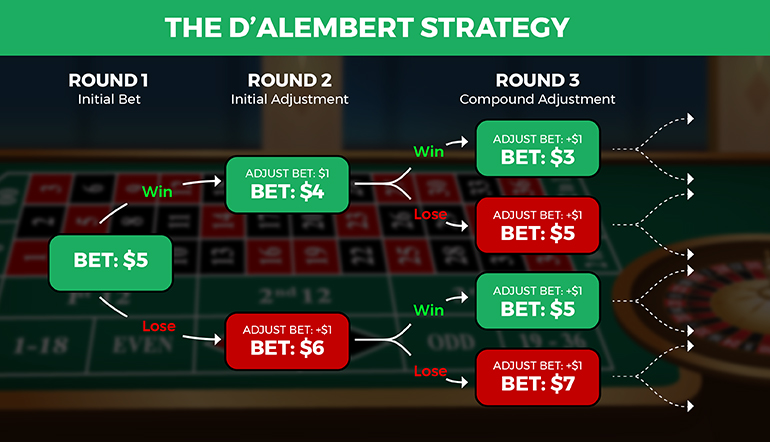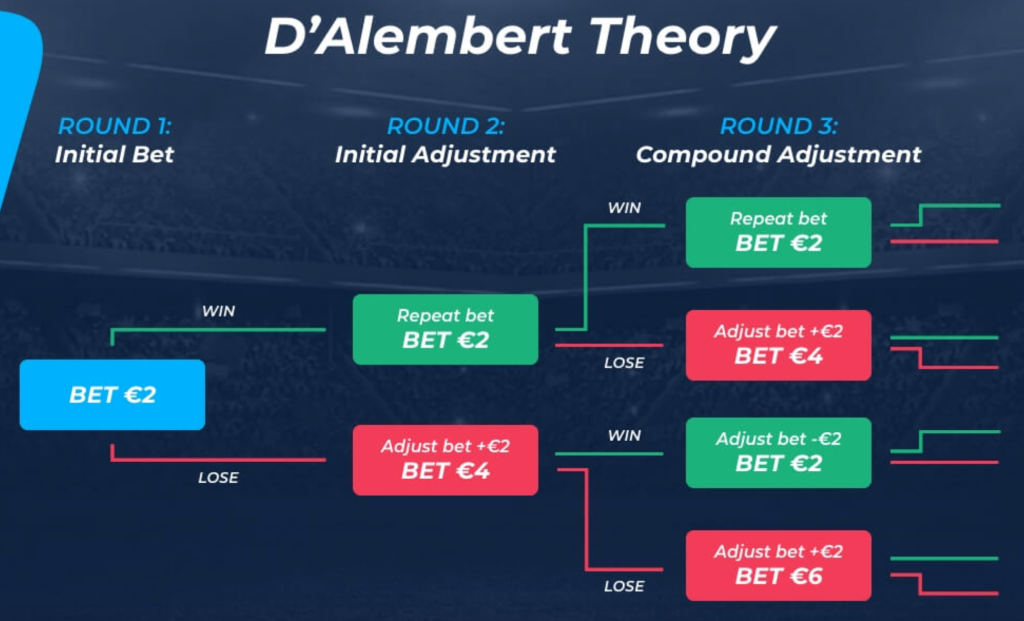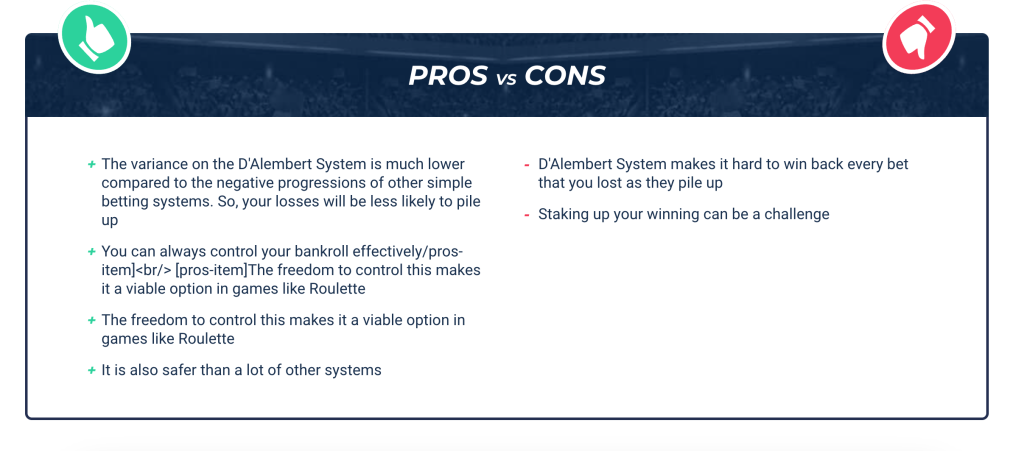
Introduction to the D’Alembert Betting System
The D’Alembert system is an excellent starting point for bettors exploring different betting strategies. Widely adopted across the sports betting industry, this system continues to gain popularity among gamblers at numerous bookmakers. This article provides a thorough overview of the system.
What is the D’Alembert Betting System?
The D’Alembert system stands out for its simplicity among betting strategies. It is highly regarded, often only second to the well-known Martingale system. This method involves a negative progression of stakes, meaning that it requires bettors to increase their stakes after a loss and decrease them after a win.
Specifically, the system dictates that bettors add one unit to their next bet after a loss. Compared to other systems, the D’Alembert method increases stakes more gradually. This slow increase reduces the risk of stakes becoming too high too quickly but also means that recovery of losses can be slower. The lower risk in individual losses comes at the cost of potentially higher overall losses due to this slow recovery.
History of the D’Alembert Method
Originating in the late 18th century, the D’Alembert formula was named after its creator, a French mathematician. Initially developed for gambling, it was designed to recover losses by increasing bets after each loss, under the assumption that future bets would likely win and thus compensate for the deficits.
Even in the 21st century, the D’Alembert method remains prevalent in betting circles, appealing to players who favor straightforward betting strategies.
Understanding How the D’Alembert Method Works
To effectively utilize the D’Alembert method, it’s crucial to grasp its mechanics. The method is designed not only for potential real money wins but also to sustain profitability even through a series of losses.
However, users should be aware of the cost implications, as the system can become expensive with the endless possibilities of loss sequences. While it may promise short-term profitability, the long-term success can vary significantly based on sequence outcomes.
How to Implement the D’Alembert Method
Applying the D’Alembert method involves adhering to its four foundational rules:

RULE 1 – Decide Your Base Unit
Firstly, establish your base unit, which will serve as your standard betting stake. While this unit can be any percentage of your bankroll, it is wise to keep it at 5% or lower, with an optimal starting point of about 2%.
RULE 2 – Begin with One Unit
Start your betting sequence by placing a stake of one base unit. This is your initial wager in the cycles of the D’Alembert system.
RULE 3 – Increase Stakes After a Loss
Following a loss, increase your next wager by one additional base unit. This gradual increase helps manage the risk while attempting to recover losses.
RULE 4 – Decrease Stakes After a Win
Conversely, after securing a win, decrease your next stake by one base unit. This rule helps to safeguard your winnings by reducing the bet size in response to successful outcomes.
By understanding and applying these rules, bettors can effectively manage their funds while using the D’Alembert betting system. This strategy offers a balanced approach to gambling, providing a systematic method to handle wins and losses.
Applying the D’Alembert System in Sports Betting
Understanding how the D’Alembert system functions in real-world scenarios can greatly enhance its application, particularly in sports betting. Here’s a detailed example of how it can be implemented effectively:
Foundation of the D’Alembert System: Unit-Based Betting
In this system, the amount you bet is based on units. For instance, if $10 represents your initial bet, this amount becomes your primary base unit.
Incremental Stakes Adjustment
Suppose your first bet of $10 is a loss. According to the D’Alembert system, you would increase your stake by one unit for the next wager, making it $20. If this second bet also results in a loss, you would then increase the stake by another unit to $30 for your third bet. This pattern of increasing stakes continues with each loss, incrementally adjusting the wager based on previous outcomes.
D’Alembert Betting System Applied to Football
Applying the D’Alembert betting system to football betting is straightforward. Here’s how you might proceed:
- Start with Your Base Unit: Let’s say you decide your base unit is $10. Your first bet on a football game would therefore be $10.
- Adjust Stakes Based on Outcomes: If your first $10 bet loses, your next bet would increase to $20. If you win the second bet, you then reduce the next bet back down to $10. If the second bet loses, you increase to $30, and so forth.
- Manage Your Bankroll: Always ensure that your bankroll can support the potential increase in bets, especially during a losing streak. The gradual stake adjustment either upward or downward helps manage the risk while striving for recovery of losses and eventual profits.

Pick the match event you are planning to bet on. Look at the betting odds and choose the team you want to bet on. Make sure the odds are at least 2.00. You can start with £100 on your bet, with conditional bets 2. Place £100 and if it doesn’t pass, put £200. If that doesn’t pass, put £300 and then £400. If it passes, you will get £800 from doubling the £400. The process continues like that.
By consistently applying these principles, you can leverage the D’Alembert system to minimize large losses and enhance the potential for steady, incremental gains in sports betting. This methodical approach can be particularly effective in games like football, where betting markets often provide clear, binary outcomes (win/loss) that align well with the system’s strategy of adjusting stakes.
Exploring Other Applications of the D’Alembert System
The D’Alembert betting system is versatile and can be utilized in various sectors, not limited to sports betting. This section explores different ways the system can be adapted and implemented in various games and betting strategies.
Aggressive System Play and Variations
The D’Alembert system can be used as a foundation for more aggressive betting strategies. By modifying the rate at which bets are increased or decreased, bettors can customize the system to suit their risk tolerance. One notable variation is the reverse D’Alembert system, which flips the standard model by increasing stakes after a win and decreasing them after a loss, offering a fresh approach to managing bets.
D’Alembert System for Roulette
Roulette is particularly well-suited to the D’Alembert system due to its structure. The system’s popularity in roulette stems from its simplicity and the level of control it offers players. By systematically adjusting bets based on the outcomes of spins, players can potentially minimize losses while capitalizing on winning streaks.
D’Alembert System for Blackjack
In blackjack, the D’Alembert system enhances gameplay by allowing players to adjust their bets based on wins and losses. The strategy involves increasing the bet amount gradually after each loss and potentially winning back more through larger bets. This continuous adjustment can increase the chances of recovering losses over several hands.
Exploring Variants of the D’Alembert System
The D’Alembert system is adaptable, with several variants that cater to different betting preferences:
- Multi D’Alembert Progression: This variation is used in games like roulette, involving both positive and negative progression strategies. Depending on the game dynamics and betting circumstances, these progressions can be tailored to be either more conservative or aggressive.
- The Reverse D’Alembert: This method reverses the traditional betting progression, increasing stakes after wins and decreasing them after losses. It offers an alternative approach that some players may find more congruent with their betting styles.

D’Alembert Betting System FAQ
❔ Who was D’Alembert?
D’Alembert was a renowned French mathematician who developed the D’Alembert betting system in the 18th century. His system, initially designed for even-money betting scenarios, continues to influence betting strategies today.
🏆 Is the D’Alembert Strategy Illegal?
No, the D’Alembert strategy is perfectly legal. It is widely recognized as one of the safer betting systems and is used by gamblers worldwide without legal restrictions.
💶 Is the D’Alembert System Allowed at Bookmakers?
Yes, many online bookmakers permit the use of the D’Alembert system. However, it’s advisable to check a bookmaker’s policy regarding betting systems beforehand to ensure compatibility.
💳 Is the D’Alembert Betting System Safe?
The D’Alembert system is safe and legitimate. When used correctly, it does not jeopardize your betting account or payment methods, offering a structured way to manage bets.
🤔 Can I Bet on Football with The D’Alembert Method?
Absolutely. Football betting can effectively utilize the D’Alembert system. By applying the method’s principles to the fluctuating odds and stakes typical in football betting, players can enhance their chances of achieving consistent wins.







